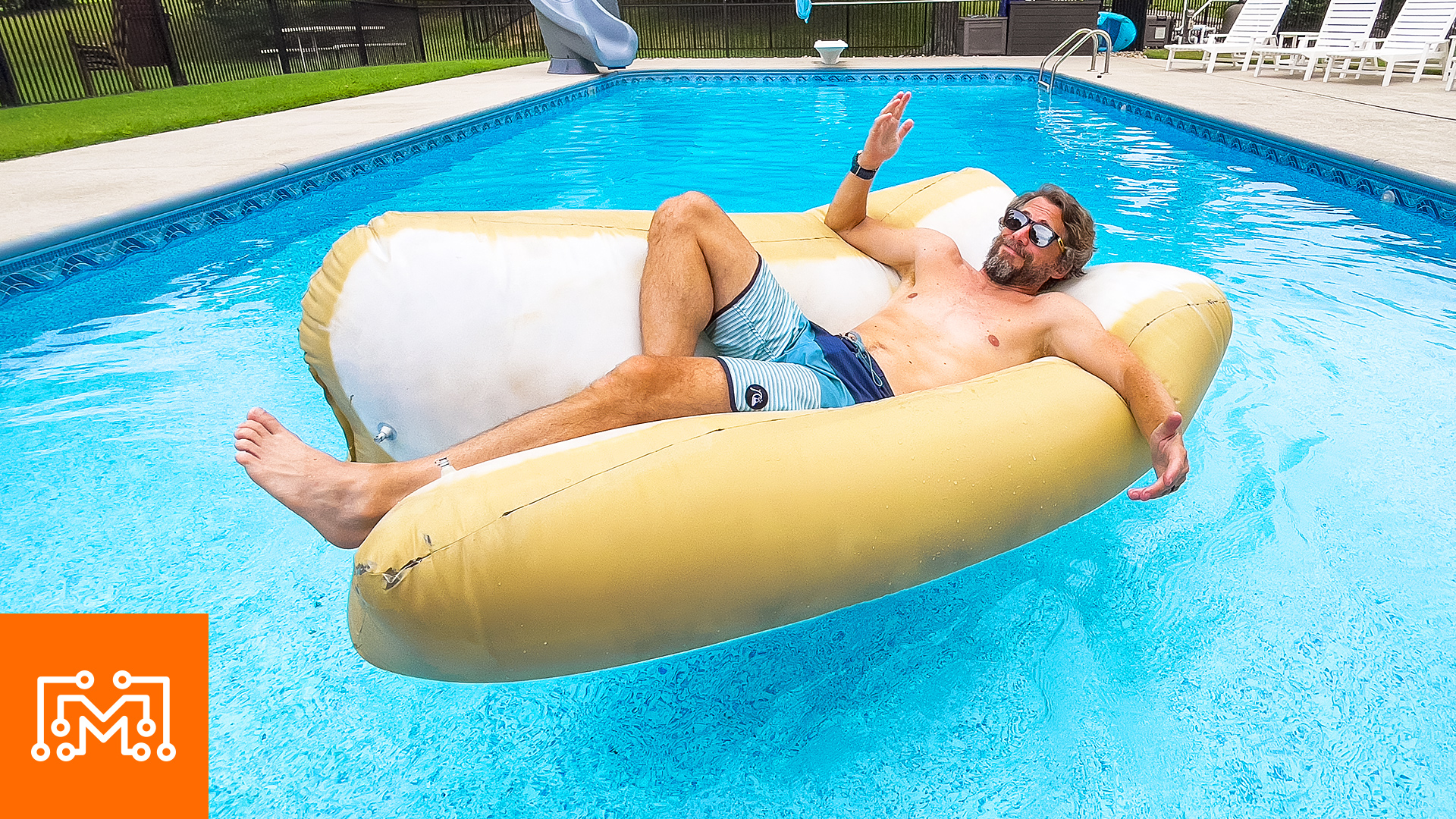You know, I’d always wondered if you could make your own pool float, and I’ve also wondered what it would be like to be a hot dog. Naturally, I decided to combine these two thoughts and make an inflatable hot dog bun. For the past five or six years, I’ve been fascinated by the idea of creating a custom inflatable that I could lay on and float across a pool. But there’s a glaring problem: hardly anyone makes their own pool inflatables, which means there’s very little information on how to do it.
The internet is sparse when it comes to the specifics—what materials to use, what kind of adhesive works best, how to make seams that hold air. Despite these hurdles, I decided it was time to experiment. With summer in full swing, I bit the bullet, gathered what little information I had, and set out to see if I could make it happen. My goals were straightforward but ambitious: create something that holds air and keeps me afloat. The first step was figuring out the material. I couldn’t find any definitive sources, so I headed to the local fabric store and picked up some marine vinyl to start my journey.
 Next came the challenge of binding the vinyl pieces together. I had two options: heat or adhesive. For the heat option, I found a small iron meant for molding leather, thinking it could melt the seams together. On the adhesive front, I stumbled into a lucky situation. I had ordered vinyl cement from Amazon, and the very next day, I received an email from a company with a new vinyl cement product they wanted me to test. This perfect timing led me to try out Rockford’s Vinyl Cement Plus.
Next came the challenge of binding the vinyl pieces together. I had two options: heat or adhesive. For the heat option, I found a small iron meant for molding leather, thinking it could melt the seams together. On the adhesive front, I stumbled into a lucky situation. I had ordered vinyl cement from Amazon, and the very next day, I received an email from a company with a new vinyl cement product they wanted me to test. This perfect timing led me to try out Rockford’s Vinyl Cement Plus.
 Testing the adhesive was an eye-opener. I glued two pieces of vinyl together and tried to pull them apart, only to find that the plastic ripped before the glue did. The iron, on the other hand, was a bust—it either melted the vinyl completely or didn’t bond it at all. Thankfully, Rockford’s adhesive worked perfectly. With my material and bonding method settled, I moved on to creating a prototype. I cut out two rectangles, glued them together to make a pillow shape, and added a mouth valve to inflate it. This step was crucial to ensure my inflatable could hold air.
Testing the adhesive was an eye-opener. I glued two pieces of vinyl together and tried to pull them apart, only to find that the plastic ripped before the glue did. The iron, on the other hand, was a bust—it either melted the vinyl completely or didn’t bond it at all. Thankfully, Rockford’s adhesive worked perfectly. With my material and bonding method settled, I moved on to creating a prototype. I cut out two rectangles, glued them together to make a pillow shape, and added a mouth valve to inflate it. This step was crucial to ensure my inflatable could hold air.
 Turning my attention to practicality, I realized making inflatables involves a lot of trial and error. My initial test showed some minor leaks, which I patched up to see if I could get a better seal. The process of turning the glued seams inside out was tricky but necessary for a clean finish. I laid the vinyl in the sun to soften it and smooth out the wrinkles before continuing. The first successful prototype boosted my confidence—I had an airtight, watertight inflatable, albeit a small one.
Turning my attention to practicality, I realized making inflatables involves a lot of trial and error. My initial test showed some minor leaks, which I patched up to see if I could get a better seal. The process of turning the glued seams inside out was tricky but necessary for a clean finish. I laid the vinyl in the sun to soften it and smooth out the wrinkles before continuing. The first successful prototype boosted my confidence—I had an airtight, watertight inflatable, albeit a small one.
 Encouraged by this success, I decided to go bigger. I purchased a 3D model of a hot dog and used a free tool called Plushify to create a pattern. This tool, originally designed for making plush toys, helped me turn the 3D model into a printable pattern. The plan was ambitious: make a giant hot dog inflatable. However, the thinner vinyl I initially used caused problems when applying the adhesive, leading me to switch to a thicker material.
Encouraged by this success, I decided to go bigger. I purchased a 3D model of a hot dog and used a free tool called Plushify to create a pattern. This tool, originally designed for making plush toys, helped me turn the 3D model into a printable pattern. The plan was ambitious: make a giant hot dog inflatable. However, the thinner vinyl I initially used caused problems when applying the adhesive, leading me to switch to a thicker material.
 Despite some setbacks with the thin vinyl, a flat iron turned out to be an excellent tool for melting seams together. I combined this method with adhesive to ensure strong, airtight bonds. After some trial and error, I managed to create an inflatable hot dog that could hold air without leaking. To finish it off, I painted the hot dog for a more realistic look. Then it was time to tackle the buns, which were larger and had simpler shapes, making them easier to assemble.
Despite some setbacks with the thin vinyl, a flat iron turned out to be an excellent tool for melting seams together. I combined this method with adhesive to ensure strong, airtight bonds. After some trial and error, I managed to create an inflatable hot dog that could hold air without leaking. To finish it off, I painted the hot dog for a more realistic look. Then it was time to tackle the buns, which were larger and had simpler shapes, making them easier to assemble.
 Finally, it was time for the ultimate test: would my hot dog float keep me above water? Borrowing my neighbor’s pool, I carefully laid on my creation. To my surprise and delight, it held up beautifully, supporting my weight without any leaks. I even took it to the diving board for a more rigorous test, and it still performed admirably. This project was a mix of creativity, problem-solving, and a touch of whimsy, but in the end, my inflatable hot dog bun was a BIG success.
Finally, it was time for the ultimate test: would my hot dog float keep me above water? Borrowing my neighbor’s pool, I carefully laid on my creation. To my surprise and delight, it held up beautifully, supporting my weight without any leaks. I even took it to the diving board for a more rigorous test, and it still performed admirably. This project was a mix of creativity, problem-solving, and a touch of whimsy, but in the end, my inflatable hot dog bun was a BIG success.





